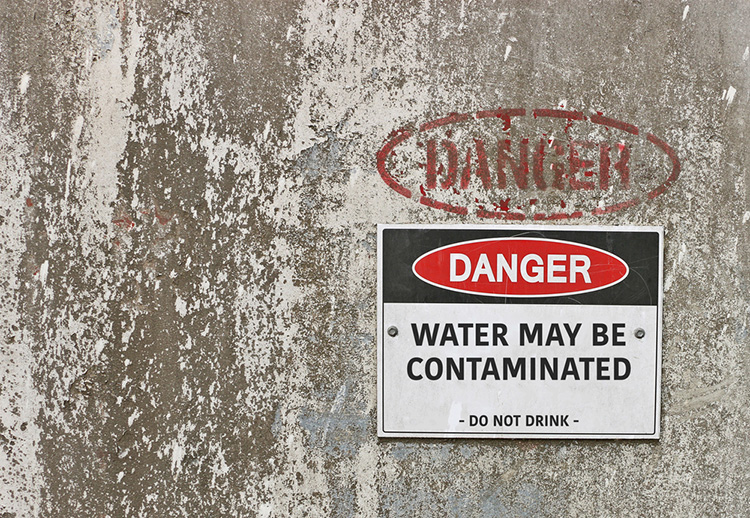
Approximately 15 percent of Americans rely on private wells as their primary source of drinking water according to the Environmental Protection Agency (EPA). While public water systems are required by the EPA under the Federal Safe Drinking Water Act to test for certain contaminants, and to take action when contaminant levels exceed defined thresholds (Maximum Contaminant Level (MCL)), private wells fall outside of the EPA’s rubric.
Who is responsible for the quality of well water?
Some state governments regulate private wells at the time it is dug and when the property in which it resides is bought or sold. However, it’s the well owner’s ongoing responsibility to monitor the quality of the water drawn from the private well and treat it if its contaminant levels exceed the MCL or state action level. Through recommend action levels, the state can spur treatment of well water contaminants for which no federal MCL exists, in order to reduce health risks.
The EPA has also established National Secondary Drinking Water Regulations (NSDWRs) that set non-mandatory water quality standards for 15 contaminants to assist private well owners in managing their drinking water for aesthetic considerations such as taste, color, odor, staining, and technical effects such as scale formation, corrosion, and clogging. The current best practice is to test for microorganisms annually and repeat the broader water potability tests every five years.
Common Water Contaminants & How to Eliminate Them
Here are several common well water contaminants and recommended solutions to keep you and your family safe:
- E. coli Concern Level: Medium – High
Most strains of E. coli will not cause major harm and already reside in your intestines. However, healthy cows are known for carrying a specific strain of E. coli, O157: H7, which produces a powerful toxin, which can cause severe illness. Sewage runoff from farms containing this E. coli strain can permeate nearby water sources leading to dangerous contamination. For those with wells near animal farmlands, it is a bacteria to test for annually. If E. coli is indicated, shock chlorination of the well water system and boiling drinking water is recommended until further testing shows a complete absence of the contaminant. Chlorination is recommended for ongoing E. coli treatment. - Copper Concern Level: Low
Though copper is a naturally occurring metal, it can have serious health implications. Copper finds its way into well water through industrial wastewater, mining operations, and corrosion of copper-made pipes. High levels of this metal can cause digestive issues, blood toxicity, and liver problems. The presence of copper, and similarly lead, maybe due to low pH, where acidic well water is leaching metal from copper pipes, and lead solder joints. An acid neutralizer can raise the pH to an alkaline value and prevent or significantly reduce contamination. If the contamination is naturally occurring, not arising from corrosion, then the best way to remove this contaminant is through reverse osmosis or ion exchange system. - Giardia and Cryptosporidium Concern Level: Medium – High
These parasites are commonly known for causing severe intestinal illness. Both of these have been named the top reason for waterborne illness in humans in the United States and around the world. Both Giardia and Cryptosporidium are found in every region of the U.S. and can enter private well water systems through sewage runoff, stormwater, and farmland runoff. Boiling drinking water is one recommended way of removing these parasites. Alternative methods involve sediment filtration with a rating of one-micron absolute or finer. - Radon Concern Level: High
Radon is an odorless, tasteless radioactive gas that is known for causing respiratory issues, including lung cancer. Radon is a result of the breakdown of uranium and easily dissolves in water, making it an extremely dangerous contaminant. It is common for higher levels of radon to be found where groundwater runs through granite or gravel. If you are concerned about radon in your drinking water, be sure to perform a water test immediately. The best way to remove radon from water is by using a catalytic carbon filter. After changing out this filter, be sure to dispose of it at a hazardous waste collection area and not in the trash. - Nitrate Concern Level: High
Nitrate is a naturally formed compound that is created when nitrogen combines with oxygen. Nitrate often enters well water due to poor good construction or chemical fertilizer contamination. When nitrate is consumed, it turns into nitrite, which can cause problems in infants and pregnant women according to the Centers for Disease Control and Prevention (CDCP). High levels of nitrite can cause the inability of the body to receive enough oxygen through the blood. Ion exchange systems or reverse osmosis in combination with nitrate selective media can remove nitrate from drinking water. - Chromium-6 Concern Level: High
Chromium is a naturally occurring element that can be found in rocks, plants, and soil. This element has two common forms that are found in water systems: chromium-3 (trivalent) and chromium-6 (hexavalent). While chromium-3 is an element our bodies rely on as a dietary supplement, chromium-6 is a dangerous element that has been linked to cancer, kidney damage, and internal bleeding. This toxic element is often found in well water due to industrial wastewater, mineral leaching, and fossil fuel contamination. Be vigilant in preventing this substance from entering your body by testing your water more frequently than the recommended 5-year interval. Consider a reverse osmosis system to remove it from your drinking water if your area is known to have chromium-6 contamination.
Take control of your Well Water with The Perfect Water Purification System
Bottom line, education is your best defense when it comes to protecting yourself and your family from water contaminants. Private well water can be made safe through regular testing and proper filtration systems. Learn more about Well Water Systems here. The water experts at The Perfect Water can help you find the water filter system that works best for you and your home.
